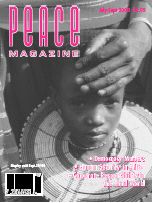
Peace Magazine Jul-Sep 2000, page 29. Some rights reserved.
Search for other articles by PMag staff here
Dan Hallock,Plough Publishing 1999, $12.00 U.S.
In Bloody Hell, author Dan Hallock makes an idealistic effort to put faces to the human cost of war. Rather than approaching this subject intellectually, this book goes for the gut. Story upon story, conflict upon conflict are touched upon. Topics include the disillusionment with the military life, the lifelong effects of service, "corollary damages," selective coverage of information, political justification, and healing.
The chapter "Bloody Century" lays the historical groundwork of wars in this century, mostly those which involved Britain: World War I, World War II, the Falklands conflict, the Gulf War, and also Vietnam, the source of the most wrenching stories. The section on World War I shows aspects of war that are to be repeated throughout the century; the economic prosperity that comes to a war's suppliers, the use of propaganda and secrecy of material facts to keep the public supportive, the use of repressive legislation to discourage protest, and the indifference to huge losses of life. The human side of this war is shown with letters from a British soldier describing German camaraderie in the trenches.
While soldiers from all conflicts suffered, those who fought in Vietnam and to a lesser extent, the Gulf War, seem to have particular remorse at how the war was waged, recognizing that the brutality went beyond what was necessary militarily. In addition, many soldiers have come to question the motives for these two conflicts. Much of the Gulf War slaughter - the "turkey shoot" and mass live burials of virtually incapacitated Iraqi soldiers - were performed at a distance so that personal guilt was often minimized. The one-on-one personal brutality common in Vietnam, however, has left many soldiers with guilt and recurring psychological problems. The difficulty of surviving such carnage was compounded by the angry silence that greeted veterans' return home. A 1990 U.S. study shows that these veterans have been left with high rates of both physical ailments and psychological dysfunction even 20 years after service.
Many of the accounts of the Americans in Vietnam - there are none from the Vietnamese soldiers themselves - display a profound lack of insight. One senses an emotional numbness that closes off critical examination of their lives. The author draws parallels between military training and cult indoctrination to explain this: American military training produces a "group think" that negates the individual's judgment, with the humiliating discipline producing an anger born of pent-up frustration. Hallock's contention is that the changes in personality from this tend to be permanent.
There were wonderful sketches of real heroes; men who had developed the insight and had the strength of character and the courage to stand up for justice under the most difficult conditions.
Bloody Hell produces some interesting revelations, such as one by an American "anti-terrorist" sharpshooter operating in Central America. "Inserted" at night and working in pairs, they killed targeted people at a distance of up to 3,000 feet. In one of the sharpshooter's stories, the Pentagon had him take nighttime potshots at GIs stationed in Panama weeks before the invasion "to get them riled up" at Panamanians.
The book is successful in portraying the human suffering in war. However, the sheer number of stories is overwhelming and the length too great to absorb. Although war crimes and crimes against humanity were mentioned, there was no focus on this subject. A chapter on war crimes would have added another dimension to this book and provided yet another reason to avoid armed conflicts.

Peace Magazine Jul-Sep 2000, page 29. Some rights reserved.
Search for other articles by PMag staff here